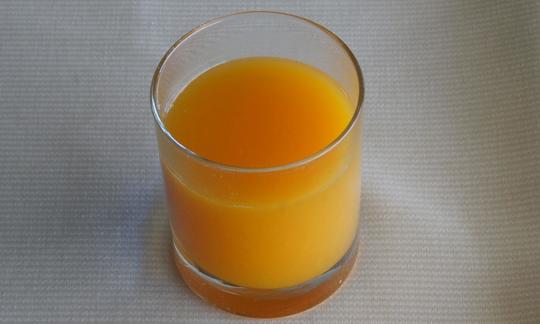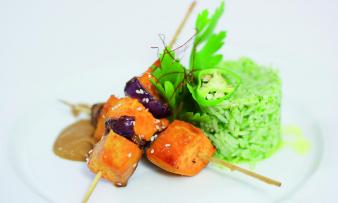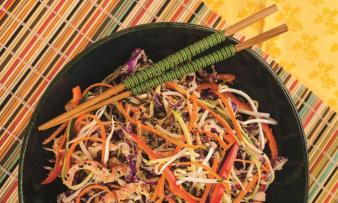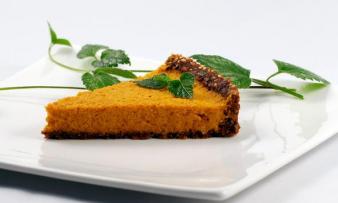Table of contents
Orange juice is extremely popular. People like to drink it raw and pure in the morning, but it can also be used to enhance soups, salad dressings, desserts and much more. Organic orange juice is preferable.
Use in the kitchen
Orange juice is obtained by squeezing raw oranges ( Citrus sinensis ). This tastes different depending on the type of orange and the processing method, but is usually sweet and sour. The consistency depends on whether or not it contains pulp. Blood oranges are used to make blood orange juice. Orange juice is the most consumed fruit juice in the world. 1
A distinction is made between fresh juice, direct juice and fruit juice from concentrate. Freshly squeezed orange juice without further processing is called fresh juice. Direct orange juice is juice pressed from fruit and then pasteurized. The heating serves to preserve the juice. When orange juice is made from orange juice concentrate, freshly squeezed orange juice is processed into concentrate in the country of production. The concentrate and flavoring are then transported to the consumer country, where orange juice is reconstituted by combining concentrate, flavoring and water and preserved by pasteurization. Whether orange juice is a raw food product depends on the production process (maximum temperature).
Orange juice is a popular breakfast drink - pure, diluted with water , as a multivitamin juice or with a little sparkling wine (also non-alcoholic) as a mimosa. It is often used in homemade iced teas, cocktails and mocktails. It also tastes good in hot drinks (eg spiced orange juice with cinnamon , cloves and anise ).
The juice can also be used for cooking and baking. There are both sweet and salty orange juice recipes. It refines soups (e.g. with pumpkin , carrots or tomatoes ) and sauces, tastes wonderful in salad dressings with mustard and agave syrup (e.g. with a raw carrot or red cabbage salad) and gives a risotto that certain something. Braised fennel or braised root vegetables such as carrots or parsnips in an orange juice sauce with red onions , garlic and thyme is recommended. Briefly fried tofu and vegetables in an Asian, sweet and sour orange juice sauce served with jasmine rice is also a successful vegan dish.
Orange juice also gives a fruity note to breakfast dishes such as muesli (e.g. pea muesli ), semolina porridge or smoothie bowls and all kinds of vegan desserts such as creams, sorbets, gateaux, cakes (e.g. apricot-orange tart ) and cookies. Fruit salad not only benefits from orange juice in terms of taste, but also visually - orange juice prevents cut fruit from turning brown.
Note: Orange juice and orange nectar are not the same. Fruit juice consists of 100% fruit, while the fruit content of fruit nectar is 25-50%. In addition to fruit juice or fruit pulp, fruit nectar also contains water and sugar .
Homemade
Fresh orange juice is easy to make yourself. The best way to do this is to use juice oranges (pressed oranges). They are usually a little smaller than eating oranges, but they produce more juice. Valencia Late, Canoneta, Salustiana and Navel Powell are all juice orange varieties.
You can get the juice from the orange by squeezing it by hand, using a manual lemon squeezer or an electric juicer. Before doing this, you should roll the oranges over the table a few times with a little pressure - this loosens the pulp. Then halve the oranges and squeeze out the juice.
How many oranges for a glass of juice? One orange gives about 80-100 ml of raw juice (about 5-7 tablespoons). Two to three oranges are therefore enough for a glass of juice.
Vegan recipe for raw carrot salad with orange juice dressing
Ingredients (for 4 people): 850 g carrots, 100 ml raw orange juice (preferably freshly squeezed from an organic orange), 3 tbsp rapeseed oil , 2 tbsp lemon juice , 1 tbsp agave syrup, some salt andpepper .
Preparation: Rinse the carrots, peel if necessary, cut off the ends and grate with a kitchen grater. For the vegan orange juice dressing, mix the orange juice, oil, lemon juice and agave syrup and season with salt and pepper. Add the dressing to the grated carrots and mix well. Either serve immediately or leave covered in the fridge to sit for a while.
Vegan recipes with orange juice (raw) can be found under the note: " Recipes that have the most of this ingredient ".
| Not only vegans or vegetarians should read this: Vegans often eat unhealthily. Avoidable nutritional mistakes . |
Purchasing - Storage
Orange juice can be bought all year round in most supermarkets (e.g. Coop , Migros , Denner , Volg , Spar , Aldi , Lidl , Rewe , Edeka , Hofer , Billa ) and organic supermarkets (e.g. Denn's Biomarkt , Alnatura ). Major retailers also offer blood orange juice. Orange juice from concentrate is more common, but direct juice is also occasionally available. Orange juices also differ in terms of the pulp content (with or without). The fruit juice is available in composite cartons, PET or glass bottles. When buying orange juice, make sure that the juice only contains oranges (juice and possibly pulp). A high-quality orange juice does not contain any other orange juice ingredients, i.e. no added sugar .
Is orange juice vegan? Orange juice from the store is not always vegan. Some cloudy fruit juices are clarified using gelatine. Since gelatine cannot be detected in the final product, it does not have to be declared on the product. However, juices can also be filtered mechanically or using plant-based means. When buying orange juice, look for products with the vegan seal (V-Label, Vegan Flower).
If you squeeze your own orange juice, it is best to buy oranges during the season, which lasts from November to March in southern Europe.
The availability of orange juice (raw) varies depending on the size of the store, catchment area, etc. Our recorded food prices for the DA-CH countries can be found above under the ingredient image - and by clicking you can see their development at various suppliers.
Storage tips
Orange juice bought from the refrigerated section should also be kept cold at home. Unchilled orange juice can also be stored at home without refrigeration if it is unopened. After opening, it should be kept in the refrigerator and used up within about two weeks.
Freshly squeezed orange juice is best consumed immediately, otherwise within a day.
Ingredients - Nutritional values - Calories
How many kcal does freshly squeezed orange juice have? The energy content of orange juice (raw) is 45 kcal per 100 g. What are the nutritional values of orange juice? The protein content is low at 0.7 g/100g and there is hardly any fat either at 0.2 g/100g. It contains 10 g/100 g of carbohydrates, of which 8.4 g is sugar. The fiber content is 0.2 g/100 g. 2 The following are three notable orange juice ingredients (nutrients).
Does freshly squeezed orange juice contain vitamins? With 50 mg/100g (63% of the daily requirement), orange juice is rich in vitamin C (ascorbic acid) . Lemon juice (39 mg/100g) and lime juice (30 mg/100g) contain slightly less. Significantly more vitamin C can be found in yellow bell peppers (184 mg/100g). 2
Orange juice contains 30 µg of folate (folic acid) per 100 g (15% of the daily requirement). Lemon juice has a comparable content (20 µg/100g). A lot of the vitamin is present in yeast extract (spice paste) at 3,786 µg/100g, but only small amounts are used. 2
Orange juice also contains potassium (200 mg/100g; 5.0% of the daily requirement). The potassium content of lemon juice (103 mg/100g), grape juice (104 mg/100g) and apple juice (101 mg) is slightly lower, while that of carrot juice (292 mg/100g) is slightly higher. Fennel seeds contain more than eight times the nutrient at 1694 mg/100g. 2
Carotenoids and polyphenols such as phenolic acids and flavonoids (hesperidin, narirutin) are some of the secondary plant substances contained in orange juice. 3, 4,5
The complete ingredients of orange juice (raw), the coverage of the daily requirement and comparison values with other ingredients can be found in our nutrient tables. In the article Nutrients explained you will get a detailed insight into the topic.
Health Effects
Is freshly squeezed orange juice healthy? Orange juice is a rich source of ascorbic acid, carotenoids, phenolic acids and flavonoids. Its bioactive compounds are linked to the prevention of cardiovascular disease. 4 The flavanones it contains, a subgroup of flavonoids, are hesperetin-7-O-rutinoside (hesperedin) and naringenin-7-O-rutinoside (narirutin). These substances have been shown in studies to reduce the risk of ischemic stroke and acute coronary events in women and to improve vascular function. In addition, intake of hesperetin and naringenin has been reported to reduce the risk of cerebrovascular disease and asthma. 5
Moderate consumption of orange juice as part of a healthy diet and lifestyle can help to achieve recommended daily allowances of nutrients. Moderate intake does not appear to have a detrimental effect on weight, provided that intake is balanced in terms of overall diet and level of physical activity (more on this in the following chapter "Risks - Intolerances - Side Effects"). 6
Results from a 2017 study also report an improvement in insulin sensitivity and anti-inflammatory activity when a low-calorie diet is combined with orange juice. Can you lose weight with freshly squeezed orange juice? Moderate consumption of orange juice therefore offers benefits that can be associated with weight loss and increase the quality of the diet. 7,8 According to a 2020 study, the consumption of orange juice is also associated with a lower intake of industrial sugar . 8
Orange juice also has an antioxidant effect - orange juice with pulp has a stronger effect than orange juice without pulp. 9 The juice is also said to have a preventive effect on the formation of kidney stones. 10
You can find more health benefits of oranges (without peel) in the corresponding article. We cover orange peel in a separate article.
Dangers - Intolerances - Side effects
Is freshly squeezed orange juice unhealthy? High-quality orange juice contains no added sugar, but is naturally high in fructose (fruit sugar). This has been linked to the development of a number of chronic diseases or conditions such as obesity, dyslipidemia (fat metabolism disorder), insulin resistance, metabolic syndrome and diabetes. However, moderate intake of orange juice only contributes relatively small amounts of fructose to the diet (approximately 10 g per 237 ml). The Robert Wood Johnson Foundation's recommendation for daily juice consumption suggests consuming up to 118 ml for children aged 2 to 4 years, up to 177 ml for children aged 5 to 10 years and up to 237 ml for children over 11 years and adults. Parents should monitor the consumption of fruit juice in children and adolescents, especially those who are overweight and obese. 6
Because of the fructose it contains, people with fructose intolerance (hereditary fructose intolerance) and fructose malabsorption (intestinal fructose intolerance) should avoid consuming orange juice.
The citric acid contained in oranges attacks tooth enamel. You should not brush your teeth (with too much pressure) after eating or drinking acidic foods, as this will cause the upper layers of the teeth to wear down more. Instead, we recommend rinsing your mouth with water. This dilutes the acid and speeds up the replacement of dissolved minerals. 11
Ecological footprint - animal welfare
The ecological footprint of a food depends on various factors. The type of agricultural production (conventional vs. organic), average or seasonal or regional production, domestic production or import by truck, ship or plane, different types of packaging and whether the goods are fresh or frozen all play a decisive role. According to a German study from 2020, the CO 2 footprint of orange juice in a 1.0 L composite carton is 0.7 kg CO 2 eq/kg. "The Big Climate Database" puts the CO 2 footprint of canned orange juice at 1.32 kg CO 2 eq/kg. In comparison: According to the German study, raw oranges produce 0.3 kg CO 2 eq/kg, while according to "The Big Climate Database" they produce 0.81 kg CO 2 eq/kg. 12,13
Orange juice is mainly found in cardboard packaging, but also in plastic and glass bottles. The environmental impact of packaging depends on the collection systems (e.g. collection of PET, beverage cartons, glass) in the respective countries, the efficiency of the recycling processes and the amount of recycled material that is reused. Frequently used reusable bottles are the most environmentally friendly option. After reusable systems, composite cartons cause the least environmental impact. Disposable glass bottles have the highest environmental impact. 14
According to a Dutch study from 2011, a total of 560 litres of water are needed to produce 1 kg of oranges. Much more is needed for 1 kg of orange juice, namely 1019 litres of water. 15
Organic oranges and organic orange juice are preferable because organic production avoids the use of chemical-synthetic pesticides and fertilizers that are harmful to health and the environment.
In addition to the environmental impact of pesticides used in commercial orange cultivation, orange juice is problematic due to exploitative working conditions for workers. If possible, choose Fairtrade or, even better, Gepa-certified products, which stand for better working conditions and fairer wages and support small producers. 14
Worldwide presence - Cultivation
The processed orange juice sector emerged in Florida shortly after the end of World War I in response to problems related to the increasing supply of oranges on the market. Initial developments aimed to utilize oranges that were not the right size or quality for sale as fruit. The importance of these rejected oranges grew in parallel with orange production in Florida and orange consumption throughout the United States. Thus, cooperatives of orange growers and bottlers opened the first orange juice production plants to process this surplus fruit. The first processed orange juice was boiled, concentrated and canned. It was distributed at room temperature for dilution in the home. Its taste bore little resemblance to that of freshly squeezed orange juice. 16
For another group of orange growers, increasing orange production and concern about the devaluation of the fruit provoked an alternative response. In the mid-1920s, the Florida Citrus Exchange, a cooperative of orange growers, distributed orange juice presses throughout the United States. Between 1924 and 1926, 16,000 households were equipped with juice presses in an attempt to encourage orange juice consumption. Another impetus for the development of the orange juice market came in the 1930s with increasing concern about vitamin intake and nutrition among Americans. This presented an opportunity for juice manufacturers to promote orange juice for its vitamin C content. 16
Today, orange juice is the most popular and widely consumed fruit juice in the world. In 2018, it accounted for 43.8% of the total fruit juice market. 1
Brazil and the United States account for almost half of the world's orange production. In Brazil, about 70% of oranges are destined for the processing industry, while in the United States the figure is around 95%. Brazil and Florida are the main producers of orange juice. Together they produce almost 90% of the world's supply. 17,18
Industrial production
In the orange juice industry, two main types of extraction processes are used. Both processes start with washing the oranges , followed by sorting by size. The first method involves placing the fruit between two metal bowls with pointed metal tubes. The orange is squeezed between the two bowls while the tubes penetrate the fruit and collect the juice that is squeezed out. The second extraction method involves cutting oranges in half, which the machine then moves against rotating reamers to squeeze out the juice. After filtering through a stainless steel sieve, the juice can be cooled or concentrated, resulting in the production of two types of products: non-concentrated direct juices and concentrated juices. 19
Non-concentrated juices are deoiled using a centrifuge to an oil content of 0.02-0.04%. They are then pasteurized to destroy microorganisms, deactivate enzymes and thus preserve the juice. Pasteurization is carried out using plate heat exchangers or steam heating (typically at 94-85 °C for about 15-60 seconds). These direct juices are stored frozen or chilled. High-pressure pasteurization enables storage at room temperature (20 °C). 19
Alternatively, orange juice can be concentrated for better preservation, storage and transport. Orange juice concentrate is mainly obtained by thermally accelerated short-term evaporation (TASTE): orange juice is heated under vacuum with hot steam to evaporate the water it contains. The juice is restored to its original concentration by adding water, aromatic oils and essences before the product is marketed in the consumer country. Finally, the reconstituted orange juice (orange juice from concentrate) is pasteurized and packaged. 19
Stabilising treatments aimed at inhibiting microbial spoilage and inactivating degrading enzymes are mandatory to obtain orange juice with an acceptable shelf life. Thermal processes are very effective but can have adverse effects on organoleptic and nutritional properties. Many new technological approaches are currently being studied, mainly based on the use of high pressure processes and pulsed electric fields, which are intended to better preserve the bioactive substances in the juice. 19
Further information
The orange ( Citrus sinensis ) belongs to the genus of citrus plants ( Citrus ) within the rue family ( Rutaceae ). It is the result of a natural cross between a mandarin ( Citrus reticulata ) and a grapefruit ( Citrus maxima ). 20
Sweet oranges are divided into four groups: common oranges (blond oranges or round oranges), navel oranges, pigmented oranges (blood and half-blood oranges) and acid-free oranges (sugar oranges). 20 Within the group of blond oranges and blood oranges, there are some juice orange varieties.
Other related species of the genus Citrus are: bitter orange ( Citrus aurantium ), lime ( C. latifolia and C. aurantiifolia ), lemon ( C. limon ), clementine ( C. clementina ), pomelo ( C. grandis ) and grapefruit ( C. paradisi ).
Note: Since most of the plants just mentioned are hydrides, i.e. new plants resulting from crossing different species, it would be correct to put an "x" between the genus name and the species name in the botanical name, e.g. Citrus × sinensis for oranges.
Alternative names
Since oranges are also called orange juice, a synonym for orange juice is orange juice. In colloquial language, it is also called O-juice.
In English, orange juice is called orange juice.













Comments